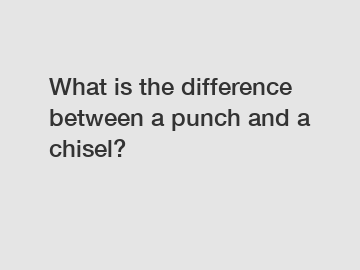Oct. 20, 2023
Tools
Sikai Product Page
When it comes to hand tools, two instruments that often grab our attention are the punch and the chisel. These versatile tools serve specific purposes, but their similarities can sometimes blur their unique functions. To establish a sound understanding and clear any confusion, this article aims to shed light on the distinct roles of punches and chisels. Through their dissimilar designs, applications, and outcomes, we can appreciate the reliability and versatility they bring to various tasks.
Design and Construction:

The first notable difference between a punch and a chisel lies in their design and construction. A punch typically consists of a slender, pointed metal rod, usually with a hardened (tempered) tip. Conversely, a chisel boasts a sturdy, flat metal blade with a sharp beveled edge. This variation in design is instrumental in defining the purpose and function of each tool.
Application:
The foremost application of a punch is to drive or align objects. Punches are invaluable in tasks that require precision and control, such as creating indentations, forming holes, or removing pins. The pointed tip of a punch allows it to exert focused force, ensuring accuracy while minimizing damage to the surrounding material.
On the other hand, a chisel is primarily used for cutting or shaping various materials. Its beveled edge enables effective carving, sculpting, or trimming of materials such as wood, stone, or metal. Chisels are frequently employed in woodworking, masonry, and other fine-tuning activities where control and detailed workmanship are important.
Outcome:
The contrasting applications of punches and chisels ultimately result in distinct outcomes. A punch efficiently allows us to create indentation or recesses with utmost precision. It excels at tasks such as starting nail holes, aligning holes for drilling, or even removing stuck bolts by driving them out from the opposite side. The precision and minimal material damage achieved through punches make them an invaluable asset in tasks that demand accuracy, such as metalworking or even jewelry making.
A chisel, on the other hand, offers an incredible ability to remove or shape materials. While a chisel may initially resemble a punch, its beveled edge enables controlled cutting and shearing actions when struck with a hammer or mallet. Whether it's crafting intricate designs in wood, carving sculptures, or shaping stones, chisels are the go-to tool for experienced craftsmen.
Safety Considerations:
Since both punches and chisels involve striking and application of forces, adherence to safety measures is crucial. Goggles should always be worn to protect the eyes from flying debris or shavings. Additionally, leather gloves provide hand protection against slippage and potential injuries caused by mishandling or glancing blows. A secure workbench or vise can prevent the workpiece from moving unpredictably, ensuring precision work and minimizing mishaps.
Conclusion:
In conclusion, while punches and chisels share some similarities in their hand tool origins, their distinct designs, applications, and outcomes set them apart. Understanding their differences is fundamental to selecting the right tool for a specific task, ensuring optimal results and productivity. Punches excel in tasks requiring pinpoint accuracy, alignment, and minimal damage, whereas chisels shine in providing unparalleled control and versatility when cutting and shaping materials. By recognizing and appreciating the unique attributes of punches and chisels, we can harness their power to elevate our craftsmanship to new heights.
Please visit our website for more information on this topic.
If you want to learn more, please visit our website Non-sparking Fork.
If you are interested in sending in a Guest Blogger Submission,welcome to write for us!
All Comments ( 0 )